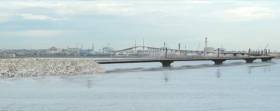Displaying items by tag: Bypass
#DublinBay - A motorway across Dublin Bay? City councillors are opposed, but State policy may make its construction inevitable, as Louisa McGrath writes in the Dublin Inquirer.
Proposals for a new stretch of high-capacity road running across or under Sandymount have been mooted for decades, with the current iteration put forward by the National Transport Authority (NTA) intended as a completion of the M50 as a ring road for the capital.
But it's prompted a stand-off with Dublin City Council, whose members recently passed nine motions to block any bypass connecting the Port Tunnel to the southern section of the M50.
They have modern civic planning – which prioritises public transport over more roads and congestion – on their side, not to mention the potential impact on South Dublin Bay communities, and the area's Biosphere status.
However, national policy has already been signed off in spite of such concerns, and the removal the bypass from the city development plan may even be in breach of the law.
As Green Party leader Eamon Ryan writes in today's Irish Independent, the situation is a "mess".
The Dublin Inquirer has much more on the story HERE.
























































